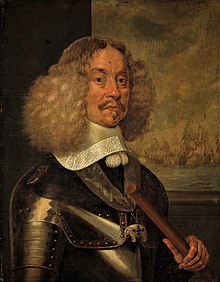Jacob van Wassenaer Obdam
| Jacob van Wassenaer Obdam | |
|---|---|

Baron Jacob van Wassenaer Obdam
|
|
| Birth name | Jacob van Duvenvoorde |
| Born | 1610 The Hague, Holland, Dutch Republic |
| Died | 13 June 1665 (aged 54 or 55) Battle of Lowestoft |
| Buried at | Grote of Sint-Jacobskerk, The Hague |
| Allegiance |
|
| Years of service | 1631–1661 |
| Battles/wars |
Eighty Years' War Capture of Maastricht Second Northern War Siege of Danzig Battle of the Sound Second Anglo-Dutch War Battle of Lowestoft † |
Jacob, Banner Lord of Wassenaer, Lord Obdam, Hensbroek, Spanbroek, Opmeer, Zuidwijk and Kernhem (1610, The Hague – 13 June 1665 off Lowestoft) was a Dutch Lieutenant-Admiral, and supreme commander of the confederate Dutch navy. The name Obdam was then also spelled as Opdam. British contemporaneous sources typically refer to him as Admiral Opdam or Lord Obdam because it was not until 1657 that he bought the Wassenaar Estate from relatives and thus acquired its title. Modern Dutch sources sometimes less correctly insert a second "van" between "Wassenaer" and "Obdam" or use the modern spelling "Wassenaar".
Jacob was born in 1610, the eldest son of Lieutenant-Admiral Jacob van Wassenaer Duivenvoorde and Anna van Randerode van der Aa. In 1631 he joined the army. On 28 April 1633 at Maarssen he married Agnes Renesse van der Aa. In 1643 he became drost (political governor) of Heusden, an important fortress town, and soon after military governor of its garrison.
As a member of the Hollandic nobility, Van Wassenaer was delegated to the States of Holland to represent their interests, as one of the ten members of the ridderschap (the "knighthood" Estate within the States). In 1650 when stadtholder William II of Orange died, he opposed installing the latter's infant son as nominal stadtholder. He bribed the nobility members of other States by promising them positions in the army. His opposition to the House of Orange was based on socio-economic and religious grounds: the stadtholders had their political base in the artisan class, which consisted mainly of puritan Calvinists. Many members of the Van Wassenaer family were still catholic and feared religious oppression. When the First Anglo-Dutch War started in 1652 he, then a cavalry Colonel, was again delegated to the States-General. There he supported the faction of Johan de Witt and Cornelis de Graeff who proposed to build a strong professional confederate fleet, at the expense of the army. Because his father had been an Admiral he was made "Delegate of the States to the National Fleet", thereby becoming responsible for all day-to-day dealings between the States-General and the navy, a position that carried much power.
...
Wikipedia
